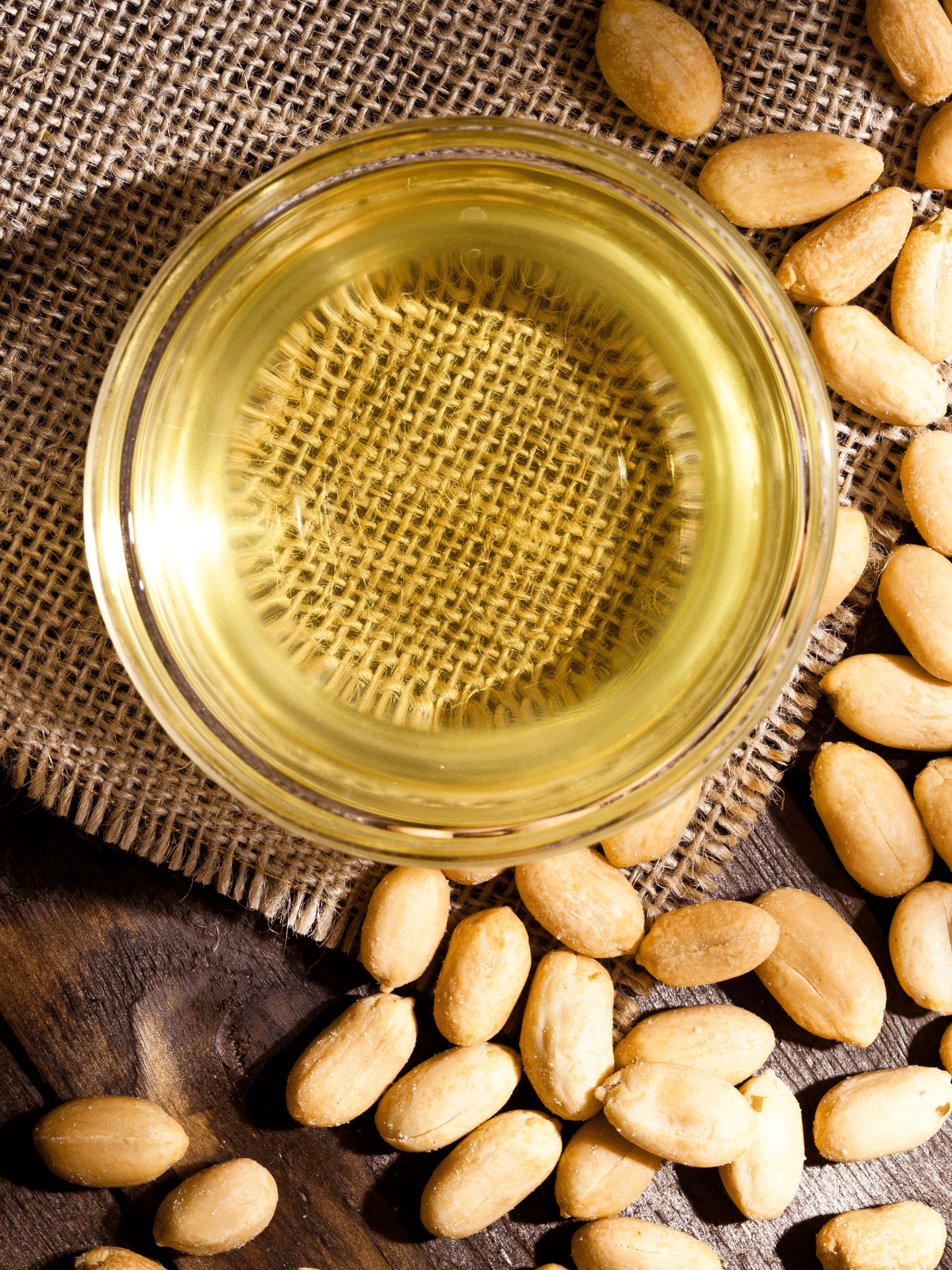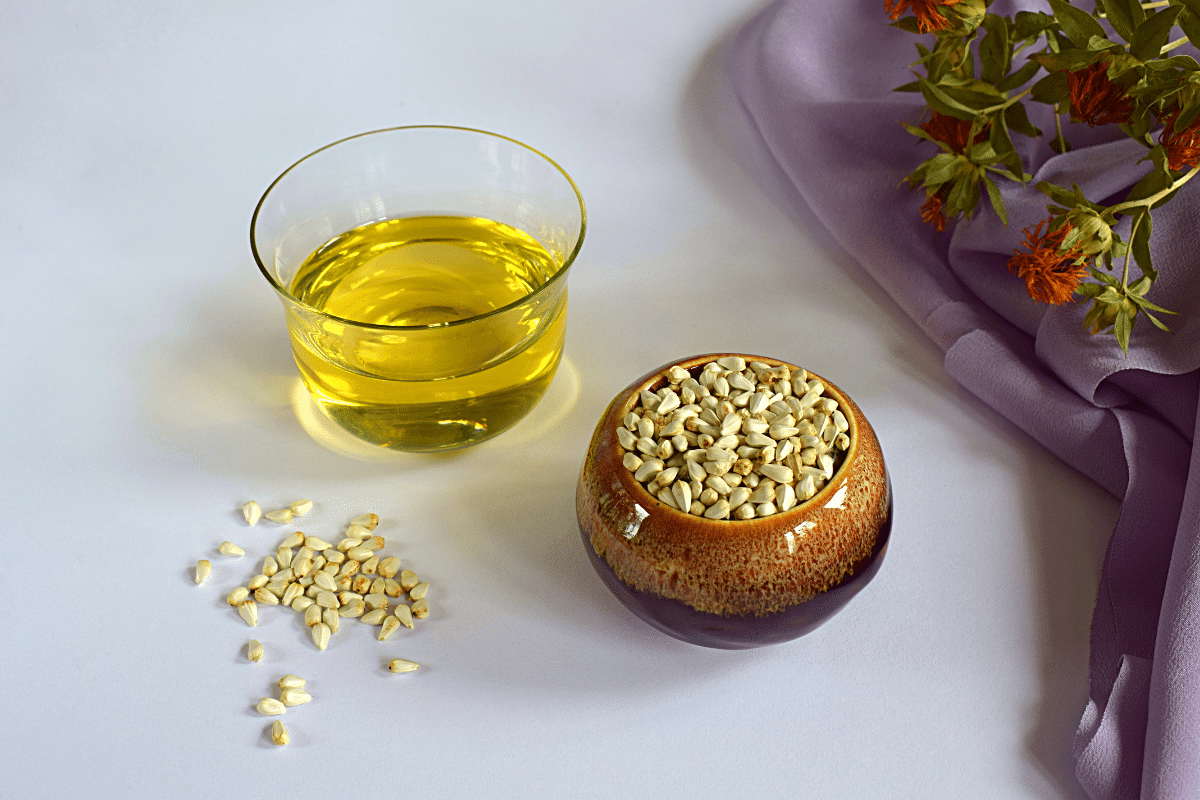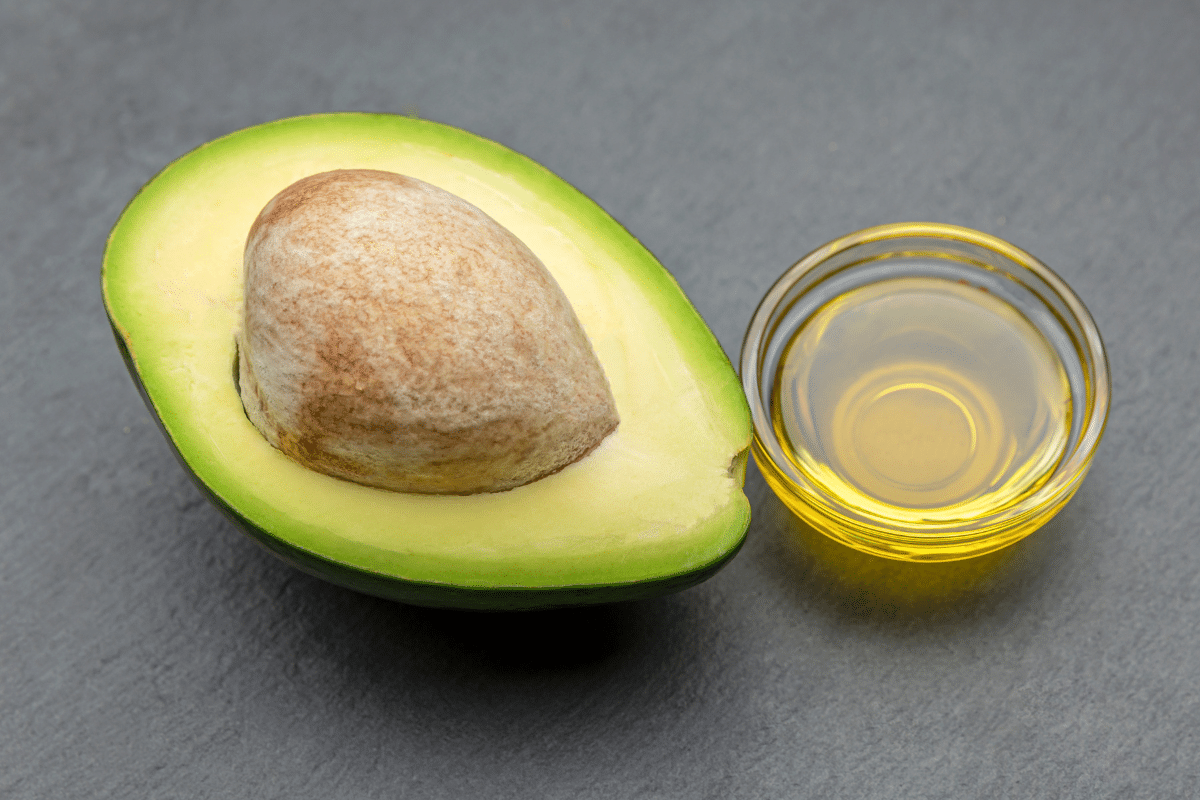Are you looking for a fantastic substitute for peanut oil?

Peanut oil, also known as groundnut oil, is one of my favorite oils to use for cooking because of its versatility. It also infuses a delicious nutty flavor that you can’t get from most oils.
There may be times when you need to use a different oil. Maybe you’ve used up all the peanut oil you have, or a more crucial one, like when one of your guests is allergic to it.
Flexibility is key when such changes are needed in the kitchen. Luckily, there are great substitutes for peanut oil that can be used for cooking, baking, making sauces or salad dressings, and as a finishing touch to a dish.
Jump to:
Reasons to Use a Peanut Oil Substitute

Peanut Allergy
This is, by far, the most important reason why I first looked into suitable replacements for peanut oil. Even if no one in your family is allergic to this legume, you can’t rule out the possibility that one of your future guests might be!
Note that peanut allergy is one of the most common food allergies in the U.S. and could lead to more serious complications like anaphylactic shock.
So whenever you’re expecting company at the dinner table, whether it’s your friends or your children’s friends, make sure to ask for food intolerance and allergies. That way, you can all enjoy a lovely meal.
Flavor
Depending on the type of peanut oil you have, you might need to find a suitable substitute oil that will fit better with your recipe in terms of flavor. Roasted, unrefined, and cold-pressed are the types of peanut oil with the most distinguishable flavor.
Of course, you can use them if your recipe does call for a nutty taste and aroma. Otherwise, you’ll need a substitute oil with a neutral aroma and flavor.
Cost
I like using peanut oil from time to time, especially if I’m sure it’s completely safe to use. It’s one of the healthier kinds of oil because of its monounsaturated fat content.
Refined peanut oil is also a great frying oil because of its high smoke point of around 450 degrees Fahrenheit. However, peanut oil, in general, can be more expensive than other commonly used oils for cooking and baking.
Availability
There will be recipes that call for the use of peanut oil, especially if the food needs an impactful nutty flavor. But sometimes you’ll find out at the last minute that there’s none left in your cupboard or you cannot simply find it in the nearest store.
8 Best Peanut Oil Substitutes and Their Pros and Cons
1. Canola Oil
Also known as rapeseed oil, this is the most commonly used vegetable oil for various reasons. It has a neutral flavor and is almost odor-free, so this oil is a great choice for pan frying or deep frying.

Its smoke point is below peanut oil, but it’s still quite high, with the refined (most widely available) type reaching up to 400°F. That means it can handle a good amount of heat without imparting any bitter flavor to your food.
Pros:
- Affordable
- High smoke point
- All-purpose oil for cooking
Cons:
- Not good as finishing oil or making salad dressings
2. Grapeseed Oil
If you’re looking for another alternative to peanut oil with no added flavor, grapeseed oil is a good choice. Its smoke point is up to 420°F, so it can be a good frying oil. If you’re making vegetable stir fry or light-searing fresh fish, this is also a good option.

I recommend using it in salad dressings because it will allow other flavors and other aromas to stand out. This is one of the oils you can try the next time you make homemade mayonnaise because of its light and clean taste.
Since this oil comes from grapes, it’s healthy, too! The only downside is that grape seed oil is more expensive than peanut oil.
Pros:
- Healthier option
- Good for a salad dressing
- Neutral, clean taste
- No aroma
Cons:
- Can be very pricey
3. Vegetable Oil
This has to be the most common oil out there. In most cases, if a recipe only mentions “cooking oil,” the safest route is to use vegetable oil — that’s how versatile this oil alternative is.

The lack of specificity in the name should give you a hint that it’s a blend of several vegetable-based fats. This is usually a cooking oil made from a mixture of corn, canola, soybean, sunflower, or palm oils.
With over 420°F smoke point, you can also use this for frying and cooking purposes. Since it has a neutral taste and smell, it would not change the outcome of your baked goods.
Pros:
- Cheap
- Great for cooking and baking
- Can be stored for a long time
Cons:
- Some options may have higher saturated fats
4. Almond Oil
Almond oil could be the answer if you have been looking for a peanut oil alternative to use as a finishing oil. Try drizzling cold-pressed almond oil on roasted vegetables or cold salads for an added nutty flavor.

You can use refined almond oil for frying, sauteing, and searing because it won’t burn easily, although you might be a bit hesitant because of its price.
If an allergic reaction is a concern, you might also want to stir clear from almond oil. According to the American Academy of Allergy, Asthma & Immunology, about 30% of people allergic to peanuts also have allergies to tree nuts like almonds, walnuts, and cashews.
Pros:
- Healthy option
- Unrefined oil is tasty for finishing dishes
Cons:
- May not be the safest option for allergy concerns
- Tends to be pricey
5. Corn Oil
If, for some reason, you can’t find canola oil to replace peanut oil, there’s a good chance that corn oil is the next best option you have. This oil is a type of vegetable-based fat that’s also very easy to find in supermarkets and relatively affordable.

While corn-flavored snacks tend to have overpowering tastes, that’s not the case for corn oil. It’s one of the best neutral-tasting oils so you can use corn oil for any cooking and most baking recipes.
Refined corn oil is also tolerant of very high heat and can handle as much as 460°F of cooking temperature. You can use it for frying or high-heat searing.
Pros:
- Inexpensive
- Versatile
Cons:
- Tends to get rancid faster than other oils
6. Sunflower Oil
Here’s another healthy oil option that can replace peanut oil for your cooking and frying needs. Refined sunflower oil can tolerate up to 450°F, so it won’t turn bitter when used for deep frying, searing, and even baking.

I know you’re here for great peanut oil substitutions, but let me tell you that sunflower oil also works in baked goods recipes that need butter!
This oil is also suitable for making salad vinaigrettes without any added flavor.
Pros:
- Suitable for many cooking recipes
- Great substitute for baking
Cons:
- Unrefined oil has a low smoke point (225°F)
7. Safflower Oil
The safflower plant, which is where this oil comes from, is related to the sunflower. Unsurprisingly, they share similarities, including having a very neutral taste and a very low aroma.

That also means safflower oil is an excellent substitute for searing meat or fish, sauteing aromatics for a stew, or even baking. Resistance to high heat cooking and baking is where safflower oil is better than sunflower oil.
Refined safflower oil can be used for deep frying and high-heat searing. It has a high smoke point that can reach 510°F.
Pros:
- Higher smoke point
- Versatility
Cons:
- Costs more than peanut oil
8. Avocado Oil
If you or anyone in your family has a peanut allergy but you still want to infuse nutty flavor in your dishes, avocado oil might be the way to go.

Unlike most oils that are extracted from seeds and nuts, avocado oil is made from the actual pulp, or flesh, of the fruit. It also happens to be one of the healthiest types of oil for cooking and baking.
However, I find the taste of its cold-pressed version a little too overpowering. I prefer its refined version because this type of avocado oil has a subtle hint of a nutty and grassy taste. It won’t overwhelm the overall flavor of any dish, making it great for searing, stir fry, and sauteing.
Refined avocado oil also has one of the highest smoke points at 520°F, which is what you want for pan frying or deep frying, and other high-temperature cooking. However, the cost of this oil will likely make you hesitate to use it in large quantities.
Pros:
- Very subtle flavor and aroma
- Great for any cooking purpose
- Healthy choice
Cons:
- Expensive
Choosing the Best Substitute for Peanut Oil
There’s no single oil that can be considered the “best” substitute for peanut oil because of the varying reasons you need to find an alternative to peanut oil. If it’s because someone is allergic, you should go for the safest options, like canola oil, corn oil, or vegetable oil blend.
These are also the three best options if you’re trying to keep your grocery spending within the budget. If there’s room to splurge and you need to use oils that can impart flavors to elevate something like the taste of your salad, you probably won’t mind getting a bottle of avocado or almond oil from time to time.

Also, don’t forget to consider what recipe you’re going to follow. Does it involve high heat cooking or frying? Then go for options with higher smoke points like corn oil.
However, if you need it to make dressings, sauces, or just a finishing oil in general, you should opt for neutral flavors like grapeseed oil, sunflower oil, and safflower oil. The last two have very neutral flavors and higher smoke points, making them great substitutes for baking.
Although pricey, almond oil and avocado oil are the best for dishes that need a distinct nutty flavor.
Helpful Tips When You Need to Replace Peanut Oil
The first challenge to finding a peanut oil substitute might be that you’re unaware of your options. That’s where this list comes in handy, so make sure to go through the pros and cons of these peanut oil alternatives.
Sometimes it can be a little overwhelming to choose an alternative. If that happens, simply narrow down your options by looking at what oils you have available at home.

Next, consider the cooking temperatures — will there be intense searing, broiling, baking, roasting, or frying? Again, note that some substitutes (like canola oil) have a lower smoke point than peanut oil.
Then, think about what the flavor of a dish should be. As a general rule, keep in mind that unrefined and cold-pressed oils have a stronger aroma and flavor, but a much lower smoke point. It’s the other way around for refined oils, which are often neutral in scent and taste, but have higher smoke points.
Whichever substitute cooking oil you use, it won’t be able to exactly replicate the same flavor you get from peanut oil. When a dish really needs to taste peanut-y, and you have to use a substitute oil, you can also chop or grind unsalted roasted peanuts and add them to the sauce or sprinkle it as a topping (if no one eating the food has a peanut allergy).
FAQs
Yes. When food allergy is not an issue, you can opt for unrefined and cold-pressed peanut oil for a more distinct nutty flavor. You can also find roasted peanut oil in stores, which makes for an amazing finishing oil.
You can refer to the “best by” or “use by” dates indicated on the label to know when peanut oil is best to use. It might not go immediately rancid after those dates, but it could lose some of its aroma and flavor. But it’s best to throw it out once it starts smelling rancid.
Yes. Olive oil can also be a substitute for peanut oil, although it’s not the top choice for frying because it tends to burn more easily than other cooking oils. Refined olive oil can work well for regular sauteing.
However, roasted peanut oil and extra virgin olive oil have different distinguishable flavors. They may not be the best substitute for one another if used for salad dressings and when drizzled on cooked meals.
Can’t Use Peanut Oil? No Problem!
Now that you have several cooking oils to choose from instead of peanut oil, don’t hesitate to try these substitutions in various recipes. You can whip up a crunchy, yet sweet snack, like this S’mores Wontons recipe by frying this tasty dessert using canola or vegetable oil.

As for me, I’m excited to use grapeseed oil to make homemade mayonnaise. I know it will be a rich addition to this broccoli bacon and cheese salad recipe.
